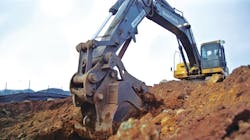Equipment, both owned and rented, may not be as large of an expense as labor or materials, but it is nonetheless a strategic variable in the infrastructure project management equation. Utilization of excavating, grading, trenching and shoring, and a wide range of other equipment can be a barometer of overall project efficiency.
Editors note: This article was contributed by United Rentals, and originally ran in Grading & Excavation Contractor.
For any contractor with a significant fleet of vehicles and heavy equipment, active and effective fleet management provides insight and visibility into utilization and opportunities. Equipment fleet management software can help reduce downtime, optimize fleet operations, and decrease the total cost of ownership (TCO). All these factors contribute to improving work site productivity and the business bottom line.
Achieving effective fleet management is nearly impossible these days without a good fleet management software solution. Digital tools, such as low-cost sensors, GPS technology, and telematics, are powering cloud-based fleet management software to manage both owned and rental equipment.
The most important fleet management features will vary from contractor to contractor, but a well-designed user interface, easy-to-use dashboards with one-click actions, automated reporting, and easy integration with internal back-office systems can make a platform more effective. Platforms that include a mobile app bring decision-making closer to the work which increases worksite efficiency and saves money on underutilized equipment.
Photo: United Rentals
Here are nine ways fleet management software can improve a contractor’s business:
1. Improve equipment visibility
Thanks to telematics, fleet management software can pinpoint, typically on a map, where every connected equipment asset is located at any point in time. This tracking can even extend to assets spread across multiple work sites. The system will allow a contractor to easily find “hidden” equipment, reduce yard scavenger hunts, and avoid the costly transferring of equipment from site to site unnecessarily. Optimally, the software enables equipment visibility in real-time from any device.
2. Prevent theft
The software can provide geofencing alerts that notify a construction firm when an asset isn’t where it should be, which will help reduce theft and unauthorized use.
3. Track and increase utilization
Contractors can’t improve what they don’t measure. With software that tracks utilization by asset type or a specific asset over time, fleet owners and managers will be able to identify underutilized equipment. With this tracking knowledge, they can either reallocate the equipment to a work site that needs it or evaluate the assets as potential equipment rental candidates.
4. Monitor driver and operator behavior
Reviewing reports on how an asset is being driven or operated can lead to improved worker safety and asset longevity. Speeding, heavy braking and acceleration, frequent reverse travel and other behaviors may signal the need for operator feedback, coaching or retraining.
5. Plan and execute predictive maintenance
Just-in-time maintenance based on factors such as engine hours, which some fleet management software tracks, will help reduce long-term maintenance costs. It can also help preserve the lifespan of vehicles and equipment. Fleet management software helps a company in creating maintenance schedules for each asset based on usage. Fault code alerts will provide a tip-off to problems before they lead to costly failures.
6. Understand TCO
Most fleet management solutions allow contractors to view the costs associated with owning and operating a specific piece of equipment, including maintenance costs. Knowing the TCO for each asset or asset class is critical to making strategic, data-driven decisions on how to optimize replacement cycles and when it is more cost-effective to rent instead of own.
7. Keep compliance
Vehicle and equipment inspection checklists and reminders help ensure that a company is following regulations, making it easier to comply with appropriate regulations.
8. Lower operating costs
Equipment fuel usage reports and alerts related to excessive idling can help a company to lower fuel costs. Addressing predictive maintenance will help lower repair and preventive maintenance costs.
9. Reduce manual administrative processes
Third-party software that’s easy to integrate with in-house applications will reduce manual data input and administrative redundancies.
Rental equipment fleets require close management to keep a cap on total equipment spending. Fleet management software will help contractors pinpoint the location of both rented and owned equipment and schedule reports and alerts, including geofencing alerts. These solutions allow companies to benchmark their utilization across a variety of asset classes against industry peers and quantify cost savings of improved utilization. Low-utilization alerts and role-based notifications that inform the right manager of overspending on purchase orders, or of late returns, will help companies spend less on rentals.
Increasingly, fleet management software includes mobile app accessibility that keeps users informed while on the go and enables them to take quick actions to get work done. The software can also allow splitting equipment costs across purchase orders and integrate with internal ERP systems to streamline procurement, billing, and payment processes.
Managing a fleet of vehicles and equipment is a complex undertaking. The right fleet management software will impact a contractor’s business by making it easier to properly maintain assets, track and increase utilization, and make smarter purchasing and rental decisions.





